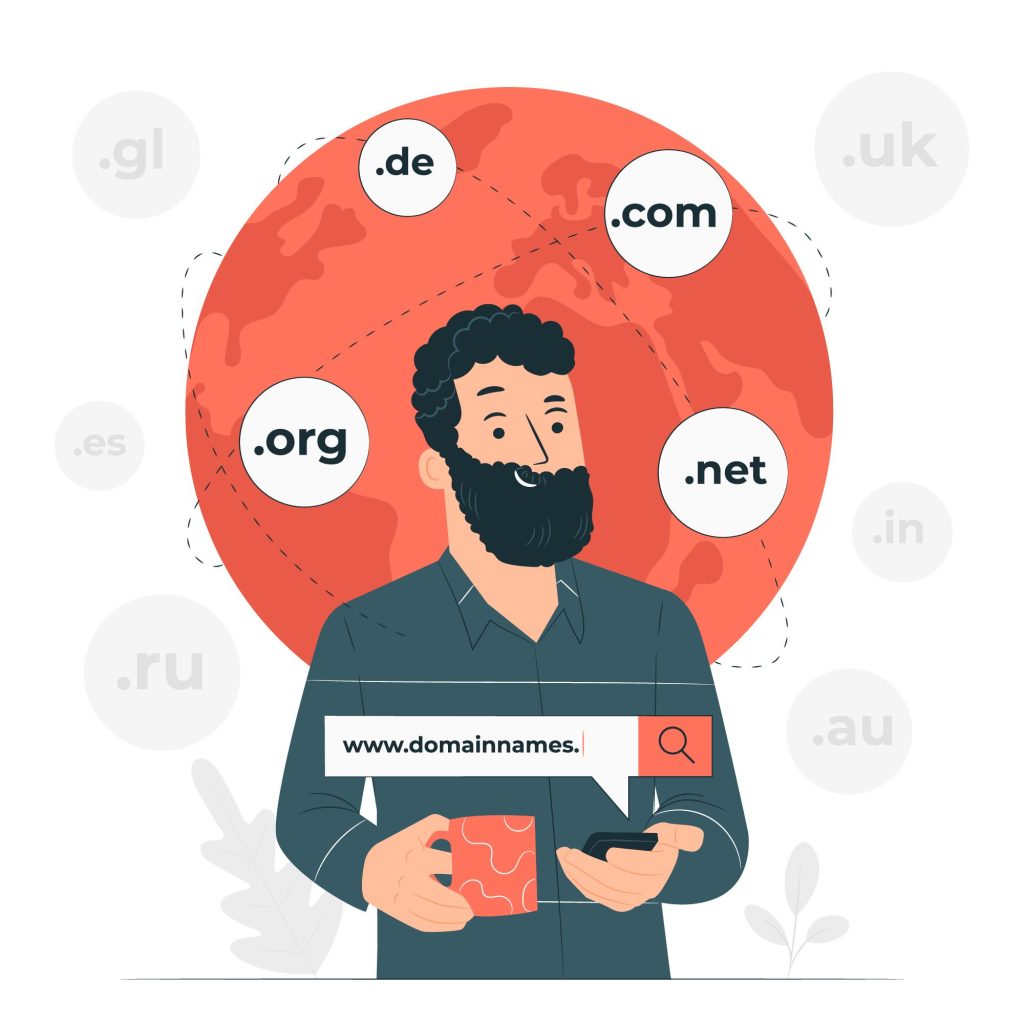Establishing an online presence has become essential for businesses and individuals alike. One of the key elements in building a website is selecting a suitable domain name. A domain name serves as an address for your website on the internet, allowing users to access it easily. Choosing the right domain extension, also known as a top-level domain (TLD), is equally important. we will know about the top-level domains and explore their significance in the online realm.
What is a Top Level Domain (TLD)?

A top-level domain (TLD) is the last segment of a domain name, appearing after the final dot. It represents the highest level in the hierarchical domain name system (DNS) structure. TLDs are classified into two main categories: generic top-level domains (gTLDs) and country code top-level domains (ccTLDs).
1. Generic Top-Level Domains (gTLDs)
Generic top-level domains (gTLDs) are domain extensions that are not specific to any country or geographic region. They are widely used across the globe and cater to various industries, interests, and purposes. Some popular examples of gTLDs include .com, .org, and .net. Let’s take a closer look at these gTLDs and their applications.
.com – Commercial
The .com domain extension is arguably the most recognizable and widely used TLD globally. Originally intended for commercial entities, it has now become the go-to choice for businesses, organizations, and individuals alike. Having a .com domain lends credibility and professionalism to a website, making it a popular choice for e-commerce platforms, service providers, and online businesses.
.org – Organization
The .org domain extension is primarily associated with non-profit organizations and initiatives. It is commonly used by charitable organizations, educational institutions, and community-driven projects. Having a .org domain can help establish trust and legitimacy, as it is often perceived as a reliable source of information or a platform for social causes.
.net – Network
The .net domain extension was originally designated for network infrastructure purposes. While it still serves that function, it has also found broader applications in various online ventures. It is commonly used by technology companies, internet service providers, and network-oriented platforms. Having a .net domain can imply a focus on connectivity, technology, and online networking.
2. Country Code Top-Level Domains (ccTLDs)
Country code top-level domains (ccTLDs) are domain extensions that are associated with specific countries or geographic regions. They are used to indicate the geographical location or target audience of a website. Each country has its own ccTLD, such as .us for the United States, .uk for the United Kingdom, and .ca for Canada. Let’s explore the significance of ccTLDs and their implications.
.us – United States
The .us domain extension is the ccTLD for the United States. It is often used by businesses, organizations, and individuals who primarily target a U.S.-based audience. Having a .us domain can help establish a local identity and build trust among American users. It is particularly relevant for small businesses, local services, and government entities operating within the United States.
.uk – United Kingdom
The .uk domain extension serves as the ccTLD for the United Kingdom. It is commonly used by businesses, institutions, and individuals operating within the UK market. Having a .uk domain can enhance visibility and recognition among UK-based users, signaling that a website is tailored to their specific needs and preferences. It is often favored by e-commerce platforms, news outlets, and regional organizations.
.ca – Canada
The .ca domain extension represents the ccTLD for Canada. It is widely utilized by Canadian businesses, organizations, and individuals who seek to target a Canadian audience. Having a .ca domain helps establish a local presence and fosters trust among Canadian users. It is particularly advantageous for local businesses, tourism websites, and government institutions operating within Canada.
Factors to Consider when Choosing a Top-Level Domain (TLD)

1. Relevance to Your Industry or Niche
A top-level domain is relevant to your industry or niche. By incorporating industry-related keywords into your domain, you can instantly convey your website’s purpose and attract relevant traffic. For example, if you operate a tech blog, using a TLD like “.tech” or “.blog” can help establish your website’s identity.
2. Target Audience Location
Considering the geographical location of your target audience is crucial. If your business primarily caters to a specific country or region, using a country code top-level domain (ccTLD) can enhance your website’s visibility in local search results. For instance, “.uk” for the United Kingdom or “.de” for Germany.
3. Branding and Memorability
Your domain plays a pivotal role in your brand’s identity. Opt for a TLD that aligns with your branding strategy and resonates with your target audience. Choosing a memorable and catchy domain can boost brand recall and make it easier for users to remember and revisit your website.
4. SEO Friendliness
SEO is Important for enhancing your website’s visibility in search engine results pages. While TLDs don’t directly impact SEO, they can indirectly affect your website’s rankings. Consider choosing a TLD that reflects your website’s content and purpose to make it easier for search engines to understand your website’s focus.
5. Trust and Authority
Establishing trust and authority is essential in the online landscape. Certain TLDs, such as “.gov” or “.edu,” convey credibility and trustworthiness. However, these TLDs are generally restricted to specific entities. Choosing a reputable TLD can positively impact users’ perception of your website and enhance its authority.
6. Availability and Cost
The availability of your desired domain name and its associated TLD is a critical consideration. Some popular TLDs may have limited availability, making it challenging to secure your preferred domain. Additionally, pricing for different TLDs can vary significantly. Research and compare the costs associated with different TLDs before making a decision.
7. Future Scalability
Consider the long-term goals and scalability of your website. If you plan to expand your online presence or target additional markets, opting for a generic top-level domain (gTLD) that isn’t tied to a specific country or industry can offer more flexibility and adaptability in the future.
8. Legal Considerations
Before finalizing your TLD choice, ensure that it doesn’t infringe upon any trademarks or copyrights. Conduct a thorough search to avoid any potential legal issues that may arise from selecting a domain name that conflicts with existing trademarks.
9. Security and Privacy
Website security and privacy are paramount concerns for both website owners and visitors. Some TLDs offer enhanced security features, such as domain privacy protection, which helps protect your personal information from being publicly accessible. Evaluate the security features associated with different TLDs and choose accordingly.
10. Localization and Internationalization
If your website caters to a global audience, consider using a TLD that reflects your international presence. Country code TLDs can be effective for targeting specific countries, while gTLDs can be more versatile for international reach.
11. Social Media Compatibility
Social media presence is crucial for most businesses. Ensure that your chosen TLD aligns with the social media platforms you plan to utilize. Consistency across your website and social media profiles can strengthen your brand identity.
12. Length and Readability
Short and concise domain names are often more memorable and user-friendly. Avoid excessively long domain names that may be challenging for users to type and remember. Keep your domain name concise and easy to read.
13. Hyphenation and Numbers
While hyphens and numbers can sometimes be necessary, they can also make your domain name more complex and less memorable. Use them sparingly and only when absolutely necessary to maintain simplicity and clarity.
14. Domain Name System (DNS) Management
Consider the ease of DNS management associated with different TLDs. Ensure that the TLD you choose offers user-friendly DNS management tools or integrates well with your preferred domain registrar.
15. Renewal and Transfer Policies
Review the renewal and transfer policies of different TLDs before making your selection. Understand the renewal fees and duration to ensure that you can maintain ownership of your domain without any unexpected surprises.
16. Domain Name Extensions (ccTLDs and gTLDs)
Explore the various domain name extensions available, including both country code top-level domains (ccTLDs) and generic top-level domains (gTLDs). Each extension has its own advantages and considerations, so evaluate which ones best align with your website’s goals.
17. Industry Standards and Trends
Stay updated with industry standards and trends related to TLDs. Certain industries may have specific TLD preferences or restrictions, so staying informed will ensure that your domain aligns with current practices.
18. Competitor Analysis
Analyze the TLD choices of your competitors to gain insights and inspiration. While it’s essential to differentiate your brand, understanding the TLD landscape within your industry can help you make more informed decisions.
19. Professional Email Address
A professional email address can contribute to your brand’s credibility. Ensure that your chosen TLD allows you to create email addresses that reflect your brand identity.
20. Language Considerations
If your website caters to a specific language or linguistic region, consider using a TLD that aligns with that language. Localized TLDs can help establish a stronger connection with your target audience.
21. Subdomains and Subdirectories
Evaluate whether your website requires the use of subdomains or subdirectories. Certain TLDs may restrict or complicate the creation of subdomains or subdirectories, so choose accordingly.
22. Link Building and Backlink Profile
Consider the impact of your chosen TLD on link building and backlink profile. While TLDs don’t directly affect link building, they can influence how other websites perceive and link to your domain. Choose a TLD that fosters a positive backlink profile.
23. Registering Multiple TLDs for Brand Protection
To protect your brand and maintain control over your online presence, consider registering multiple TLDs associated with your domain name. This prevents competitors or malicious actors from using similar domains to confuse or deceive users.
FAQs
Choosing a gTLD, such as .com, offers several advantages. Firstly, gTLDs are universally recognized and familiar to internet users worldwide, making them more memorable. Secondly, gTLDs have a broader application and can cater to various industries and purposes. Lastly, gTLDs are often associated with professionalism and credibility, lending legitimacy to your online presence.
Yes, in most cases, you can register a ccTLD even if you are not physically located in the corresponding country. Some ccTLD registries may have specific eligibility requirements or restrictions. It is advisable to consult with a domain registrar or service provider to ensure compliance with the registry’s policies.
While TLDs themselves do not directly impact search engine optimization (SEO), they can indirectly influence your website’s performance. Search engines, like Google, consider various factors, including relevancy and geographical targeting, when ranking websites. Choosing a TLD that aligns with your target audience or business location can potentially improve your website’s SEO.
In most cases, changing a domain’s TLD after registration is not a straightforward process. It typically involves acquiring a new domain with the desired TLD and migrating your website’s content and settings. Changing your domain’s TLD can impact your website’s SEO and may require implementing proper redirects to ensure a seamless transition.
While there are no strict guidelines for choosing TLDs based on industries, certain domain extensions have gained popularity within specific sectors. For example, the .io domain has become prevalent among technology startups, while the .edu domain is reserved for accredited educational institutions. It is advisable to research industry trends and consider the perception of different TLDs when selecting one for your website.
Choosing the right TLD for your website depends on various factors, including your target audience, industry, and branding strategy. Consider the purpose and identity of your website, and select a TLD that aligns with your goals. Conduct thorough research, analyze market trends, and consult with domain experts or professionals to make an informed decision.
While TLDs don’t directly impact SEO, they can indirectly influence your website’s visibility. It’s essential to choose a TLD that aligns with your website’s content, purpose, and target audience.
Numerous domain registrars offer domain name availability searches. Conduct a search using your desired domain name and explore the available TLD options.
Yes, it is possible to register multiple TLDs for the same website. This can help protect your brand and expand your online presence.
Country code TLDs (ccTLDs) are generally associated with specific countries, but some may have relaxed registration policies that allow individuals or businesses outside the country to register them.
It’s generally recommended to keep your domain name short and concise, preferably under 15 characters. Longer domain names can be more challenging to remember and type accurately.
Conclusion
Selecting the right top-level domain (TLD) is a crucial step in establishing a successful online presence. Whether you opt for a generic top-level domain (gTLD) or a country code top-level domain (ccTLD), each choice carries its own implications and advantages. By understanding the significance of different TLDs and considering your specific needs, you can make an informed decision that aligns with your website’s goals and target audience.


